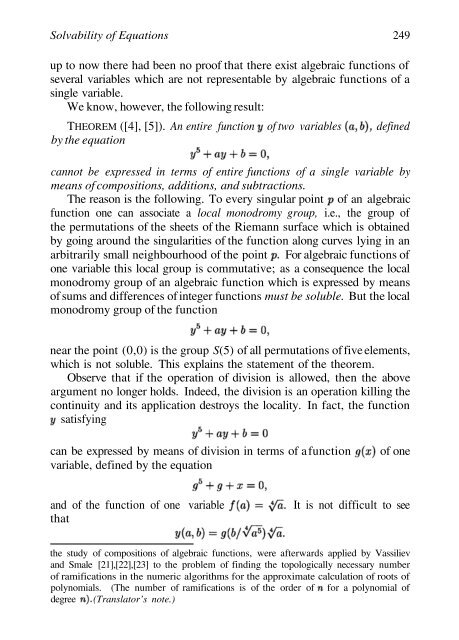Abel's theorem in problems and solutions - School of Mathematics
Abel's theorem in problems and solutions - School of Mathematics
Abel's theorem in problems and solutions - School of Mathematics
Create successful ePaper yourself
Turn your PDF publications into a flip-book with our unique Google optimized e-Paper software.
Solvability <strong>of</strong> Equations 249<br />
up to now there had been no pro<strong>of</strong> that there exist algebraic functions <strong>of</strong><br />
several variables which are not representable by algebraic functions <strong>of</strong> a<br />
s<strong>in</strong>gle variable.<br />
We know, however, the follow<strong>in</strong>g result:<br />
THEOREM ([4], [5]). An entire function <strong>of</strong> two variables def<strong>in</strong>ed<br />
by the equation<br />
cannot be expressed <strong>in</strong> terms <strong>of</strong> entire functions <strong>of</strong> a s<strong>in</strong>gle variable by<br />
means <strong>of</strong> compositions, additions, <strong>and</strong> subtractions.<br />
The reason is the follow<strong>in</strong>g. To every s<strong>in</strong>gular po<strong>in</strong>t <strong>of</strong> an algebraic<br />
function one can associate a local monodromy group, i.e., the group <strong>of</strong><br />
the permutations <strong>of</strong> the sheets <strong>of</strong> the Riemann surface which is obta<strong>in</strong>ed<br />
by go<strong>in</strong>g around the s<strong>in</strong>gularities <strong>of</strong> the function along curves ly<strong>in</strong>g <strong>in</strong> an<br />
arbitrarily small neighbourhood <strong>of</strong> the po<strong>in</strong>t For algebraic functions <strong>of</strong><br />
one variable this local group is commutative; as a consequence the local<br />
monodromy group <strong>of</strong> an algebraic function which is expressed by means<br />
<strong>of</strong> sums <strong>and</strong> differences <strong>of</strong> <strong>in</strong>teger functions must be soluble. But the local<br />
monodromy group <strong>of</strong> the function<br />
near the po<strong>in</strong>t (0,0) is the group S(5) <strong>of</strong> all permutations <strong>of</strong> five elements,<br />
which is not soluble. This expla<strong>in</strong>s the statement <strong>of</strong> the <strong>theorem</strong>.<br />
Observe that if the operation <strong>of</strong> division is allowed, then the above<br />
argument no longer holds. Indeed, the division is an operation kill<strong>in</strong>g the<br />
cont<strong>in</strong>uity <strong>and</strong> its application destroys the locality. In fact, the function<br />
satisfy<strong>in</strong>g<br />
can be expressed by means <strong>of</strong> division <strong>in</strong> terms <strong>of</strong> a function <strong>of</strong> one<br />
variable, def<strong>in</strong>ed by the equation<br />
<strong>and</strong> <strong>of</strong> the function <strong>of</strong> one variable It is not difficult to see<br />
that<br />
the study <strong>of</strong> compositions <strong>of</strong> algebraic functions, were afterwards applied by Vassiliev<br />
<strong>and</strong> Smale [21],[22],[23] to the problem <strong>of</strong> f<strong>in</strong>d<strong>in</strong>g the topologically necessary number<br />
<strong>of</strong> ramifications <strong>in</strong> the numeric algorithms for the approximate calculation <strong>of</strong> roots <strong>of</strong><br />
polynomials. (The number <strong>of</strong> ramifications is <strong>of</strong> the order <strong>of</strong> for a polynomial <strong>of</strong><br />
degree (Translator’s note.)

















